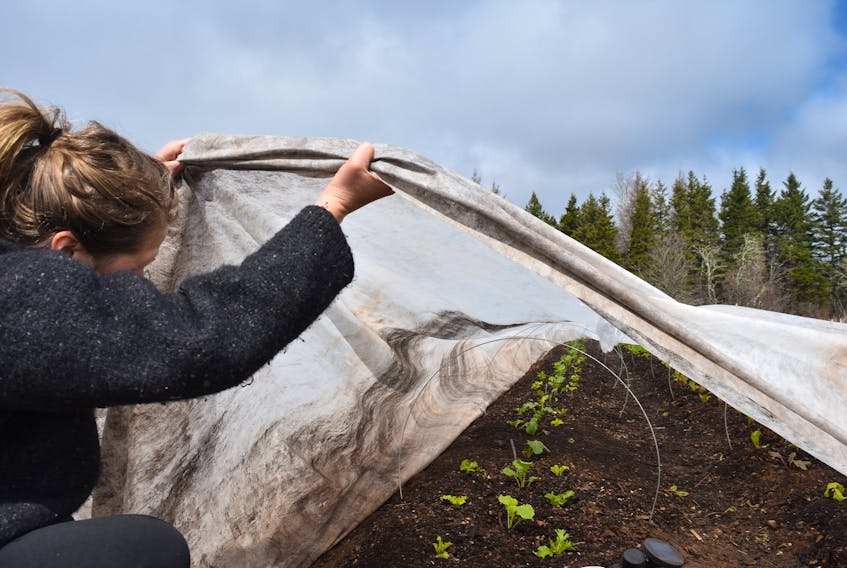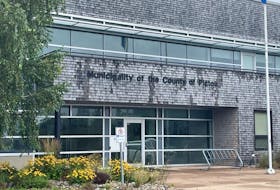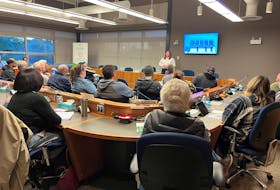A rain-filled April has been keeping some farmers on their toes this season
With the early onset of winter last November and a spring time that hasn’t brought a whole lot of sun, farmers are needing to find ways to adapt.
“I don’t mind wrestling with the weather,” said Michael Coolican of Small Holdings Farm in Millsville. “Volatility in the weather is nothing new. But I don’t want to be wrestling with the seasons.”
Coolican and Keltie Butler have been operating Small Holdings Farm since 2016. Their two main fields are named for nearby landmarks like Rockfield road and Fitzpatrick’s mountain.
Rockfield drains much better than the lower Fitzpatrick field and it’s there where both Butler and Coolican have arranged hoop houses and lain down long stretches of black silage tarps to keep off the rain and trap the heat.
“We’re not getting enough sun. So even if the plants are protected from the rain they’re slow because they’re not getting the sun they need.”
So, when the sun manages to shine during the afternoon, Butler was outside uncovering the rows of Tat Soi spinach, lettuce heads and Swiss chard growing in one of the hoop houses.
The difference that this sheet of plastic makes could be felt immediately upon stepping inside the hoop house on a chilly Friday. There was a heady smell of soil inside, and since these plants are watered regularly by hand, the little bit of sunshine that day had made it humid inside the hoop house.

You’d never know that it had snowed the night before.
Both Coolican and Butler aren’t the only growers who have had their spring season thrown out of whack.
Susan Langille, owns Lakenman’s farm on Bayview Rd. in Pictou County. The Northumberland Strait is only around two kilometres away and the high winds which postponed fishing season can be keenly felt on the property.
Usually by this time Langille says that the fields would already be tilled and ready for planning.
“Onion sets should be in the ground very soon, and probably mid to late April we’d be starting to transplant broccoli, cabbage, cauliflower, and Brussel sprouts out to the field,” said Langille.
“It’s just been too wet and too cold. When you put transplants in, even seeds, they just rot in the ground.”
Langille isn’t worried since within the next few weeks they plan to have a lot of stuff growing in the ground. But, this year has stricken some crops off the Lakenman’s list. “Last November we didn’t even get our garlic in the ground, because it was just too wet and too cold.”
Unpredictable seasons pose a fundamental problem for traditional growing. Abbey Lord, professor in the faculty of Agriculture at Dalhousie University does not hesitate in identifying where the problem stems from.
“This is the effect of climate change. It’s changing the pattern of rainfall and precipitation in general,” said Lord, who is a professor in the faculty of agriculture at Dalhousie University Truro campus.

“You have a long rainy season which shortens the growing season. Also, sometimes these longer rainy seasons come with cold night, so it doesn’t allow for even perennial crops to do well because they get shocked.”
Solution? Control the environment.
“One way we can adapt is having our greenhouses. Controlled environment agriculture. And this is something that we are looking at very seriously in the faculty of plant science, food and environment al department.”
But there’s a trade-off. Greenhouses create a controlled environment capable of creating year-round growing seasons for the farmers who use them. But there's major capital investents involved, up front and year-round.
Back at the Small Holding’s Farm there’s an alarm going off in the kitchen, a gentle beeping that tells Coolican it’s time to add more fuel to their 60 by 20 foot wood-heated greenhouse.
“We’re still trying to find out what normal is,” said Butler. “With climate change, it seems like that’s more of a moving target.”









